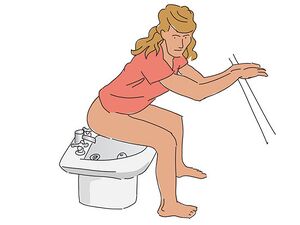Bidet
“This is a bidet, it´s for ass-washing.”
“What's the point of 'aving two fackin' toilets if the flush don't work on one of 'em?”
A bidet (US /bɨˈdeɪ/ or UK /ˈbiːdeɪ/) is not quite a toilet, and not quite a sink, but rather a third bathroom-based porcelain structure intended for washing the genitalia, inner buttocks, and anus.
Pronunciation[edit]
There is no universal consensus over the correct pronunciation, with geographical and class divisions both having influence.
British speakers of English, especially from the more humble classes, prefer to emphasise the first syllable, in case it sounds too French and racy.
American speakers of English prefer not to say it at all, but if forced to by the contents of an unfamiliar bathroom, stress the second syllable, because it has a gratifyingly similar sound to ballet, which is classy and sexless.
This is a closer approximation to the original Gallic pronunciation, but the French prefer to sass the second syllable. It's almost impossible to explain to a non-native speaker, but it helps if you convey the sensual source of delight that comes with the contemplation of a desired person's anus. On the second syllable.
History[edit]
Invention and use in ancient Rome[edit]
Homosexual loving was rampant in Ancient Rome, with many soldiers insisting on sexual acts before, during, and after battles. However, according to the contemporary code of honour, it was forbidden for all soldiers to return home to their wives with anuses full of cum, and bidets quickly developed as a suitable way to resolve the problem, with the earliest relics dating from around the 2nd century AD.
It's not clear how the bidet made its move from the battlefield to the family home, but it's generally supposed that certain high-ranking officials had the confidence to make the contentious decision to bring the bidet within the confines of their matrimonial home, and it gradually became more acceptable to conduct the post-battlefield anal ablutions within spitting distance of the wife, who in turn began to encourage the entire family to use it, so as to dilute possible connotations of adulterous buggery.
Height of popularity in France[edit]
After the sacking of Rome by the Visigoths, a tribe famous for their lacklustre attitude to clean undercarriages, the bidet fell into disuse. Written fragments from the Dark Ages suggest that some monks even mistook the remains of bidets for midgets' sinks.
It was not until the renaissance that the bidet's true function was rediscovered and it enjoyed a considerable revival. Etchings found in the ruins of Pompeii in 1516 showed an emperor's wife employing the bidet after a particularly rich and spicy banquet, and the upper classes on continental Europe began installing bidets and washing their anuses to an unprecedented extent.
Rejection after Revolution[edit]
Such was the resurgent popularity of the bidet in aristocratic Europe, it quickly became a symbol of the class's decadence. In 1992, preliminary sketches by Élisabeth Vigée-Lebrun of Marie Antoinette perching on a royal bidet, made of elephant ivory and gushing the finest champagne, were found. Although the final portrait was never painted, the sketches' existence demonstrate how central a part anal cleansing had become in the court.
In 1789, the tide turned against bidets, and revolutionaries would often smash the bidets of arrested aristocrats as a symbol of the coming change in the ruling order.
Thomas de Mahy, marquis de Favras, who was famed as having one of the cleanest rectums in western Europe, was executed by guillotine, and revolutionaries deliberately placed his bidet beneath it in order to catch his decapitated head.
Resurgence under Napoleon[edit]
For decades, the bidet fell from favour, but with rise of Napoleon came a new inspiration to use it - the mortal fear caused by the almost constant warring with the United Kingdom. In the worst conflicts, many soldiers would contract diseases as they fought in some of the most shit-flooded conditions imaginable, and Napoleon - master strategist that he was - quickly realised that if an army marches on its stomach, it needs to clean its bum.
Napoleon was widely lampooned in the UK for his creation of new portable bidets, but they did much to improve France's military footing. However, when the conflict ultimately began to turn Britain's way with the Battle of Trafalgar in 1805, the existing balance between French nerve and provision of bidets collapsed, and there were simply too many dirty bums to cope with.
Napoleon's France held out until 1815, when his forces were defeated in Belgium. Ironically, the final battle took place in uncharted countryside in the Walloon Brabant region, and the British government seized on the opportunity to christen the area "Waterloo" in mock tribute to the fallen emperor, who was duly imprisoned on the isle of Elba, where he was forbidden all bum-cleaning implements except the roughest toilet paper.
Modern bidet use[edit]
Despite its Napoleonic associations meaning it never caught on in the UK, many other parts of the developed world have embraced the bidet, although you probably shouldn't do that unless you have just cleaned it.
When and how to use[edit]
In the 21st century, bidets are used at different moments of the day, for a number of different purposes.
à la française[edit]
Arguably the most common function for the bidet is that of anal cleansing, known informally as à la française, for historical reasons. Toilet paper is generally used in even the most rustic parts of continental Europe, but the bidet will be employed on a need-to-use basis, at the user's discretion. The widely known maxim, "Quand on doute, au bidet ma choute" ("If in doubt, wash it out") is one guideline, as is the three-wipe rule, whereby after three separate pieces of toilet paper have "recorded traces of evidence", the gentleman or lady flushes the WC and "traverse la manche" or "crosses the channel" to the bidet. The user turns the tap on and faces away from it, possible fantasising briefly about straddling a horse before the splash of water finally touches the anus, when a raising of the eyebrow and a submission to a dark, sensuous pleasure is almost inevitable.
Gentleman's wash[edit]
Possibly even more traditional than à la française, anyone who employs a bidet for a Gentleman's Wash does so in the knowledge that he is following in the footsteps of homosexual Roman centurions. The modern English name reflects that here the bidet - especially when located in theboudoir of a prostituée - is an instrument of convenience for when access to a shower or bathtub is either not possible or advisable. Here, various postures may be assumed in order for the gentleman to clean himself effectively. He may choose to face the tap of the bidet (al volapié, or a vuela pies, in Spanish) and douse himself liberally, or, if he is in a trusted bidet, he may make use of the plug and fill the bidet like a baththub, and take to dunking his genitalia, in a similar motion to when one practises teabagging.
Whore's bath[edit]
A "whore's bath" (see right) is the term used to refer to the feminine version of a gentleman's wash.
I don't know how I know, but I can tell you - without a shadow of a doubt - that that woman is Italian. Just have another look at it. Imagine everything that's going on under there. Gracious.
Misuse and "Public bidets"[edit]
Bidets are neither complicated nor dangerous when used by a knowledgeable person, but cultural ignorance has led to many Britons and Americans doing themselves a bidet-based mischief.
Britons[edit]
Until the UK was granted entry to the European Union in 1973 and the British government lifted a ban on the showing of foreign movies within the British isles, no British citizen had ever laid eyes on a bidet, unless they had taken a keen interest in some of the history detailed above. This meant that when British people started to visit the continent on holiday in the 1970s, many were bemused by what they had found. Bidets were duly mistaken for drinking fountains, foot baths, bird baths, punch bowls and baby cots.
In recent years, manufactures in Ibiza have started to produce bidets with larger plug holes, in recognition of the tendency of drunken Britain tourists to use bidets as a receptacle for vomit or faeces when their friends are simultaneously shitting or throwing up into the toilet or sink in the same bathroom.
Americans[edit]
Americans are more likely not to encounter bidets on their local travels, unless they stay in a particularly sophisticated place in Mexico.
Of course, thousands of Americans make it to Europe every year, and they tend to distinguish themselves in their use of bidets in much the same way as their British cousins.
One American who moved to Europe and took the bidet to his heart was Ernest Hemingway, who wrote a detailed guide to the fixture in his non-fiction work Defecate in the Afternoon and the related novel, The Sun Also Shines Out of It.
More recently, and domestically, Americans have "super-sized" the bidet experience, with the modern phenomenon of extreme bideting, ordrunching. This fashion, which is thought to have originated in the ghettos of Atlanta, involves the illegal adaptation of a public water hydrant so it can be used to provide a powerful blast of water to the backside. It became popular among kitten huffers at the turn of the century and soon spread to the general populace via viral videos.
The craze led to tragedy in 2005, when sorority member, Paula McAdams, loved by her family and more than six dozen male members of her college, died during a drunching incident. The pretty blonde, whose last photograph features her straddling a colorful water hydrant in Kentucky, became the face of the US government's anti-drunching campaign.
The campaign itself was initially criticised for its graphic nature, with an online video featuring a reconstruction of the incident which showed McAdams being blown clean across the street into the path of incoming traffic, and billboards showing a 6-inch-diameter hole supposed to represent the grotesque size of McAdams' anus at the time of her death.
Sources[edit]
- ↑ Follow this link for the enlightening interview:http://www.youtube.com/watch?v=RpktCU145KI&t=5m5s






